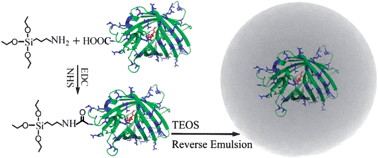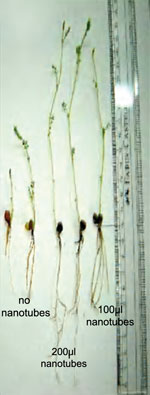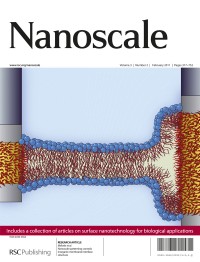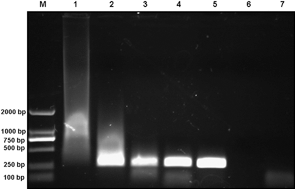Encapsulated enhanced green fluorescence protein in silica nanoparticle for cellular imaging
Zhengwei Cai, Zhangmei Ye, Xiaowei Yang, Yanli Chang, Haifang Wang, Yuanfang Liu and Aoneng Cao
Nanoscale DOI:10.1039/C0NR00956C

Scientists in China have developed a simple method of capping green fluorescent protein (GFP) in silica, which is a vital step in improving the versatility of fluorescent proteins for use as imaging probes.
Cai et al. at Shanghai University developed a covalent attachment route, which means the capping precursors are chemically bonded to the protein, rather than just providing passive encapsulation. The silica shell is then grown from the precursor layer to provide a solid and stable shell. A simple reverse emulsion method was used, and the group achieved a very high encapsulation efficiency and high protein loading. Their characterisation results suggest that encapsulating GFP in silica significantly increases its fluorescence and stability as the capping provides an effective barrier from external interference, such as protease attack, denaturants, and excessive heating.
Fluorescent probes are widely used to image biological structures and processes, both in vivo and in vitro. The main concerns in the design of these probes are their optical properties and the way they interact with their environment. For example, you may have a probe which exhibits excellent optical properties, but is toxic and therefore adversely affects the things you are trying to image. Conversely, you could have a probe which is non-toxic, but is unstable and loses its fluorescence too quickly under excitation. Traditional organic dyes suffered from various problems, including a lack of stability, broad emission profiles and toxicity issues. These have gradually been replaced with modern ‘nanoprobes’ which consist of either fluorescent nanoparticles or nanoparticulate coatings for fluorescent molecules. Of all the nanoprobes developed, fluorescent quantum dots exhibit the best optical properties, however, as they generally contain heavy metals such as cadmium, there are toxicity concerns in many applications.
The silica encapsulated fluorescent protein nanoparticles developed in this work may prove to be an exciting new probe which exhibits excellent optical and stability properties whilst avoiding problems such as toxicity and instability,
To read this article, click here.
Nanoscale DOI:10.1039/C0NR00956C













 ‘
‘


 Scientists in the US have tried to answer the question of whether biominerals are mesocrystals or not.
Scientists in the US have tried to answer the question of whether biominerals are mesocrystals or not.